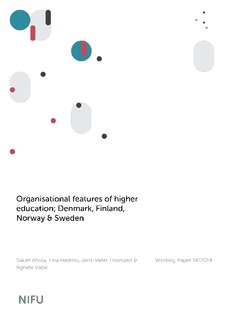| dc.contributor.author | Ahola, Sakari | |
| dc.contributor.author | Hedmo, Tina | |
| dc.contributor.author | Thomsen, Jens-Peter | |
| dc.contributor.author | Vabø, Agnete | |
| dc.date.accessioned | 2015-10-31T13:34:24Z | |
| dc.date.available | 2015-10-31T13:34:24Z | |
| dc.date.issued | 2014-10 | |
| dc.identifier.isbn | 978-82-327-0037-0 | |
| dc.identifier.issn | 1894-8200 | |
| dc.identifier.uri | http://hdl.handle.net/11250/2358908 | |
| dc.description.abstract | An overarching motive for the analysis presented in this working paper is to obtain a more systematic, empirically and comparatively based understanding of the Nordic model of higher education. A key objective is to gain a better understanding of the distinctive features of national systems that help explain recruitment patterns of students in their transition from secondary to higher education. The study has focused on the period from 1970 to 2010. | nb_NO |
| dc.description.sponsorship | NordForsk | nb_NO |
| dc.language.iso | eng | nb_NO |
| dc.publisher | NIFU | nb_NO |
| dc.relation.ispartofseries | NIFU Working Paper;2014:14 | |
| dc.rights | Navngivelse-Ikkekommersiell 3.0 Norge | * |
| dc.rights.uri | http://creativecommons.org/licenses/by-nc/3.0/no/ | * |
| dc.subject | Higher Education | nb_NO |
| dc.subject | Nordic model | nb_NO |
| dc.title | Organisational features of higher education. Denmark, Finland, Norway and Sweden | nb_NO |
| dc.type | Working Paper | nb_NO |
| dc.source.pagenumber | 106 | nb_NO |

